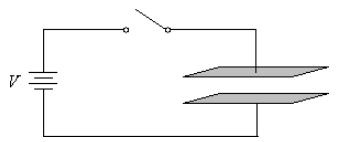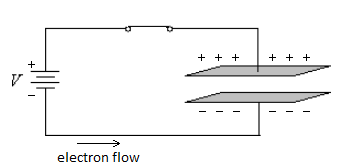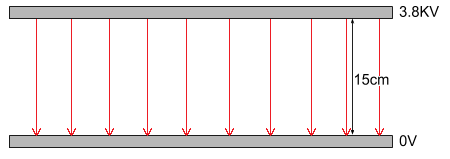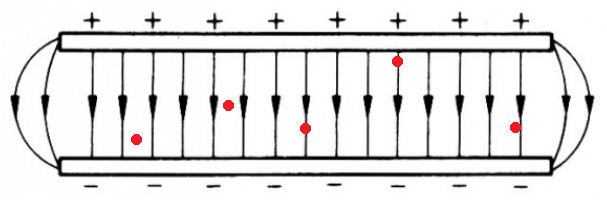Objectives:
- Be able to select and use the equation
for the magnitude of the uniform electric field strength between charged parallel plates
Electric fields don’t only exist around point charges, they can also be induced into metals. These metals can be of any shape; a sphere, a rod, or plates. There are some shapes that create field lines that are more useful than others (and can go on to accelerate particles in a controlled manner – this follows from this lessons material) such as the plates, or parallel plates. When two metal parallel plates are charged and therefore have a potential difference between them, there is also an electric field which exists in the middle.
Imagine you have two parallel plates with an e.m.f between them:
 This e.m.f supply forces electrons around the circuit (although it is not a complete circuit, electrons can be forced to flow to some degree – but the broken circuit will prevent a continuous flow around) until the build up on one of the plates. In the example above the electron flow will be anticlockwise:
This e.m.f supply forces electrons around the circuit (although it is not a complete circuit, electrons can be forced to flow to some degree – but the broken circuit will prevent a continuous flow around) until the build up on one of the plates. In the example above the electron flow will be anticlockwise: Electrons will then build up on the lower plate and there will be an absence of electrons on the top plate. The absence of electrons leaves a positively charged plate above and the excess electrons leaves a negatively charged plate on the bottom:
Electrons will then build up on the lower plate and there will be an absence of electrons on the top plate. The absence of electrons leaves a positively charged plate above and the excess electrons leaves a negatively charged plate on the bottom: Using your knowledge from the AS modules you can appreciate how small electrons are and therefore how many electrons will be stored on the negative plate. Each of these charges has its own electric field, all of which interfere with one another and also interfere with the positive plate sat in a parallel position. All of the electrons repel one another and equally spread themselves out (think back to Coulombs law). This results in electric field lines that are parallel to one another and equally spread out between the plates:
Using your knowledge from the AS modules you can appreciate how small electrons are and therefore how many electrons will be stored on the negative plate. Each of these charges has its own electric field, all of which interfere with one another and also interfere with the positive plate sat in a parallel position. All of the electrons repel one another and equally spread themselves out (think back to Coulombs law). This results in electric field lines that are parallel to one another and equally spread out between the plates: As discussed previously, the strength of the electric field is displayed by the field lines and the distance between them. Since the field lines are the same distance apart between the plates (we ignore the bits at the ends of the plates at A level), the strength of the electric field is the same throughout the entire area between the parallel plates.
As discussed previously, the strength of the electric field is displayed by the field lines and the distance between them. Since the field lines are the same distance apart between the plates (we ignore the bits at the ends of the plates at A level), the strength of the electric field is the same throughout the entire area between the parallel plates.
Since, by definition, electric fields strength is the force per unit charge, , if the electric field strength is constant and the number of charges dos not change then the force that would be exerted on any charged particle placed in that field would also be constant.
In other words, if an electron were to be placed in any of the following positions, the force acting on it would be the same:
Since the red dots represent positions of an electron, they would be accelerated towards the positive plate due to the electric field . The force that would cause them to accelerate is
, where
. This force, like any other, will cause the electrons to accelerate due to
.
Have a think: ultimately what has created this electric field and what influences its strength?
Well, the electric field is due the build up of electrons on one plate and the absence of electrons on the other plate – this has been caused due to the potential difference between the plates. Additionally the electric field will be stronger if the plates are closer together and weaker if the plates are further apart, so the distance
that separates the plates effects the electric field strength.
If the potential difference is doubled, the number of electrons on each plate must increase, therefore the electric field strength must increase. So:
If the separation of the plates increases and the electric field decrease;
Therefore and in this case the constant of proportionality is 1 (i.e.
such that
)
This is NOT the definition of electric field strength but is another equation that can be used to when dealing with parallel plates.
We know from that the units of electric field strength are
. But from the equation
the units
are also acceptable.
Deriving from
In your examinations, you may be asked to derive the Equation from the definition of electric field strength as well as other fundamental physics definitions. Give it a go yourself…
If you are struggling, use the following hints:
- Try substituting the definition of potential difference in
- You also need the definition of work done
Additionally, in your examination you may be requested to prove that is equivalent to
. Try doing this yourself, otherwise check
If you think you have done it, or would like to check then click here for the derivation for either problem above.
Example Question
Two plates are placed apart with a potential difference of
across them.

- Draw solid lines to represent the electric field both between the plates and just outside the plates. Add arrows to indicate the direction of the field.
- Using the the diagram above work out the electric field strength between the plates.
Answers:
 The plate with 0 V is considered to be the negative.
The plate with 0 V is considered to be the negative.
You must draw at least 5 field lines.
They must be equally spaced (by eye judgement).
The field lines should exit and enter the plates perpendicularly.
The field lines should not be drawn into the plates themselves (some exam boards are pick with this).
Substituting these intogives:
(2 s.f.)
Example question written by Morgan – Thank you!
Further reading:
- You should research the history of the capacitor, starting with the work of Ewald Georg von Kleist.

